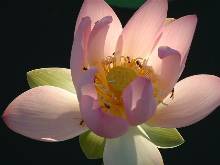 Barbara Earl Photo |
|
|
The following suggestions for winter care of lotus are from members of the Victoria-Adventure email discussion list. Growing situations vary from zone to zone so you need to adapt accordingly.
|
Babs Ellinwood, Hernando, Florida, USDA Zone 9: Here in Central Florida you can just leave your lotus in their regular environment. Don't panic because of wilted, browning leaves when the cold weather sets in. Most times unless the lotus are in ice covered, frozen solid containers they will be OK by just allowing them to acclimate to the water and air temperatures around them. We run into a problem with lotus in winter because we get tooooooooo enthusiastic with the clippers and start removing leaves to make them "look good". This destroys the delicate balance that the plant has established to maintain the tuber in its beginning dormant state. Do not cut off your leaves. Let them shrivel and sag. Then it is safe to cut them off above the water line. You don't want water getting into the green stem and having it sucked into the tuber by the air channels. If this happens, you have just "drowned" your prize tuber. We do cover our ponds with plastic if the temperatures are predicted to drop below 32°F. The plastic should not touch your plants, and a PVC pipe structure can easily be constructed to prevent that from occurring. |
||
 |
Linda (Patience) Siler, Springfield, Missouri, Zone 6: I cut the lotus that I have left over from the season back after the pads and stems have turned completely brown. I then drop them in the bottom of ponds that are at least 24 inches deep. For the ones I have growing in a bog area, I cut those back the same way and then mulch them over with bags of leaves. Then about a month before it's time to uncover them (usually about mid-March) I dump the old leaves over them. The rotting leaves feed the plants. I pull the plants that are in the deeper ponds about mid-April and repot if needed. If I can't get to them on time I postpone repotting or dividing until the next spring. However I will cut the extra growth runners any time. I hate repotting or dividing when I see very active growth because it's so easy to break those brittle grow points, no matter how careful I try to be. I would like to do it earlier, but sometimes the weather is still just too cold to work in. |
|
|
Sheila Tierney, Queensland, Australia: Here in Southeast Queensland, I just leave them where they are when they go dormant until I see them start to shoot. Then I either fertilise those in pots or transplant the larger ones. |
||
|
Soni Forsman, Eagan, Minnesota, USDA Zone 4: In the Minneapolis/St. Paul area, I drop the lotus to the bottom of the pond -- depth about 28 inches. This is our biggest pond with about 2,800 gallons of water. I do this the third week of October. By that time, they have been nipped by frost or freeze several times. All foliage has died and the wind has broken much of it. The remaining I cut back. This area of the pond is where I also winter some of my hardy water lilies. I have been doing this for at least five years and have been successful at least through last winter. |
||
|
John K. Wyman, Durham, North Carolina, USDA Zone 7b: I am speaking for myself as well as for Duke Gardens where I am a volunteer. At the Garden we have two 60,000 gallon ponds with at least seven 25-30 gallon lotus pots in them. We have been raising hardy lotus here for some time very successfully. We just leave them in the water for the winter but make sure the tops of the pots are about 5" below the surface of the water. The deepest freeze we've had here in the last 10 years was a 5" thickness of ice. Our lotus winter over in the pond as long as the tubers are considerably below the freezing ice. They do fine. We must repot every two years and make sure we fertilize properly in the spring and summer. It is extremely critical that in the repotting process we do not break the growing tips - this is not easy. They must be handled with "kid gloves". |
||
|
James Horne, Ontario, Canada, USDA Zone 4: Basically I have two approaches: 1) letting the plants die
off in the cold outdoors before draining the water and bringing
in the pots to store in a cool room without artificial light
supplementation; 2) bringing in the plants quite early in the
fall and growing them indoors while gradually inducing dormancy.
This second method allows a longer growing period and presumably
more vigorous tubers. In either case I The first method is the simplest and allows nature to basically take its course, and avoids letting the tubers freeze. Where I am, that means bringing the plants in around the end of October or early November. They have been exposed to several hard frosts by this time, but the pots and water haven't frozen with more than a light skim over them. Then the water is drained out and the "wet" soil pot is placed in a plastic container in a cool (50 degrees F) room without artificial light. "Wet" means that the soil has drained so no more water runs out, but it hasn't been dried any. Before restarting in the spring I repot the tubers carefully,
picking out the obviously dead/dying ones which tend to be dark
and feel soft. The plants will start to grow when exposed to
longer daylight cycles and warmer temperatures. This will happen
naturally in a room with outdoor light. Once growth starts (around
February in my area) I fill the containers with water to cover
the soil again. Again I do any repotting/dividing and move the lotus back
into warmer areas with better, longer light cycles in February
to get them really going well before the summer comes and I can
move them outdoors. This is done with grow lights on timers and
moving them from cooler rooms to warmer ones. I have several
rooms in my house that are kept either warmer because they are
often used (or have a woodstove) or are cooler because they seldom
get used, so they don't need to be as warm. |
||
